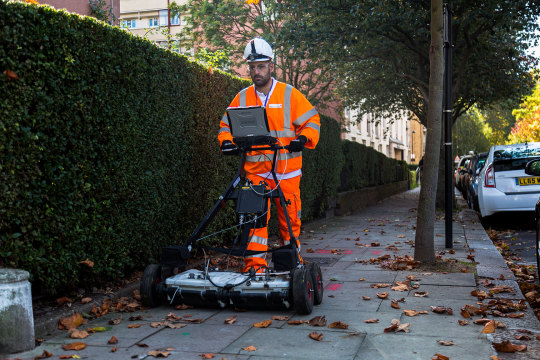#geophysical principles
Explore tagged Tumblr posts
Text
I think I made a mistake by taking both geophysics and data science in the same semester 💀💀
#up until now most of my classes have been very..... observational based I guess?#or i guess not as concrete in some respects cause the real world is never exactly like any of the perfect concepts you could discuss#and your learning has to be based around that accordingly#but for these two classes it's like Straight Up Hard Math and then a whole bunch of coding principles for organizing very real data points#which is! a lot!#I'm still gonna stick with them both though cause 1. i don't actually have any other options that fit with my schedule#and 2. there is actually no homework for geophysics so. i can probably manage it#megan.txt
3 notes
·
View notes
Text
update: I won pdrs
I get to do my first professional development review everrr at my job. like any normal person, I disregarded the question form they sent out and wrote a research paper analyzing my productivity and proficiency in the company. I'm literally gonna win pdrs
#the ceo joined my pdr alongside my manager and told me im a once in a lifetime hire#he said hes willing to open any door for me as long as i promise to walk through it#im getting specialized geophysics training + technical engineering training + im going to become a certified principle geologist
2 notes
·
View notes
Text
Paleontology Job Opening!
If anyone is looking for a paleontology job, this one in the Green River Formation in Wyoming is hiring! It's a lot of 52-MYA fish. TONS of fish. Very occasionally, there's other stuff like bats, birds, and very early horse ancestors.
$19/hour
Full time with federal benefits
App due November 25, 2024 or when they receive 80 applications (whichever comes first, so hurry!) Requirements:
One year of experience required (paid or unpaid, professional or volunteer) in "the fields of paleontology, geophysics, or geology; assisting fossil preparation, field work in paleontology, paleontology research, paleontology database management, paleontology monitoring, paleo art, or specimen management of fossils; assisting with natural resources research projects; compiling and analyzing scientific data into reports; operating complex sampling, monitoring, and laboratory equipment; or using computer programs such as databases to compile, store, retrieve, analyze and report resource management data. Experience as a laboratory mechanic or in a trade or craft may be credited as specialized experience when the work was performed in close association with physical scientists or other technical personnel and provided intensive knowledge of appropriate scientific principles, methods, techniques, and precedents."
Successful completion of at least a full 4-year course of study leading to a bachelor's degree (a) with major study in an appropriate field of physical science, such as paleontology, geology, earth science, earth history or (b) that included at least 24 semester hours in any combination of courses such as physical science, engineering, or any branch of mathematics except for financial and commercial mathematics.
I don't know if paleontologists usually have to have higher levels of education, but I think this job is called "physical technician (paleontology)" to evade that.
If you're interested, go ahead and send in an application sooner rather than later. You can always withdraw later.
This is very close to me, so if you have questions about life here (that aren't easily Googlable) I'm happy to help! It's quite rural. If you're wondering what the rental market looks like, here's a Facebook group where people post rentals. I'm mostly JTM (just the messenger) but I may have a little more insight.

40 notes
·
View notes
Text

Oceans of water found on Mars
Using seismic activity to probe the interior of Mars, geophysicists have found evidence for a large underground reservoir of liquid water — enough to fill oceans on the planet's surface.
The data from NASA's Insight lander allowed the scientists to estimate that the amount of groundwater could cover the entire planet to a depth of between 1 and 2 kilometers, or about a mile.
While that’s good news for those tracking the fate of water on the planet after its oceans disappeared more than 3 billion years ago, the reservoir won't be of much use to anyone trying to tap into it to supply a future Mars colony. It's located in tiny cracks and pores in rock in the middle of the Martian crust, between 11.5 and 20 kilometers below the surface. Even on Earth, drilling a hole a kilometer deep is a challenge.
The finding does pinpoint another promising place to look for life on Mars, however, if the reservoir can be accessed. For the moment, it helps answer questions about the geological history of the planet.
“Understanding the Martian water cycle is critical for understanding the evolution of the climate, surface and interior,” said Vashan Wright, a former UC Berkeley postdoctoral fellow who is now an assistant professor at UC San Diego’s Scripps Institution of Oceanography. “A useful starting point is to identify where water is and how much is there.”
Wright, alongside colleagues Michael Manga of UC Berkeley and Matthias Morzfeld of Scripps Oceanography, detailed their analysis in a paper that will appear this week in the journal Proceedings of the National Academy of Sciences.
The scientists employed a mathematical model of rock physics, identical to models used on Earth to map underground aquifers and oil fields, to conclude that the seismic data from Insight are best explained by a deep layer of fractured igneous rock saturated with liquid water. Igneous rocks are cooled hot magma, like the granite of the Sierra Nevada.
"Establishing that there is a big reservoir of liquid water provides some window into what the climate was like or could be like," said Manga, a UC Berkeley professor of earth and planetary science. "And water is necessary for life as we know it. I don't see why [the underground reservoir] is not a habitable environment. It's certainly true on Earth — deep, deep mines host life, the bottom of the ocean hosts life. We haven't found any evidence for life on Mars, but at least we have identified a place that should, in principle, be able to sustain life."
Manga was Wright's postdoctoral adviser. Morzfeld was a former postdoctoral fellow in UC Berkeley’s mathematics department and is now an associate professor of geophysics at Scripps Oceanography.
Manga noted that lots of evidence — river channels, deltas and lake deposits, as well as water-altered rock — supports the hypothesis that water once flowed on the planet's surface. But that wet period ended more than 3 billion years ago, after Mars lost its atmosphere. Planetary scientists on Earth have sent many probes and landers to the planet to find out what happened to that water — the water frozen in Mars' polar ice caps can't account for it all — as well as when it happened, and whether life exists or used to exist on the planet.
The new findings are an indication that much of the water did not escape into space but filtered down into the crust.
The Insight lander was sent by NASA to Mars in 2018 to investigate the crust, mantle, core and atmosphere, and it recorded invaluable information about Mars' interior before the mission ended in 2022.
"The mission greatly exceeded my expectations," Manga said. "From looking at all the seismic data that Insight collected, they've figured out the thickness of the crust, the depth of the core, the composition of the core, even a little bit about the temperature within the mantle."
Insight detected Mars quakes up to about a magnitude of 5, meteor impacts and rumblings from volcanic areas, all of which produced seismic waves that allowed geophysicists to probe the interior.
An earlier paper reported that above a depth of about 5 kilometers, the upper crust did not contain water ice, as Manga and others suspected. That may mean that there's little accessible frozen groundwater outside the polar regions.
The new paper analyzed the deeper crust and concluded that the "available data are best explained by a water-saturated mid-crust" below Insight’s location. Assuming the crust is similar throughout the planet, the team argued, there should be more water in this mid-crust zone than the "volumes proposed to have filled hypothesized ancient Martian oceans."
IMAGE: A cutout of the Martian interior beneath NASA's Insight lander. The top 5 kilometers of the crust appear to be dry, but a new study provides evidence for a zone of fractured rock 11.5-20 km below the surface that is full of liquid water — more than the volume proposed to have filled hypothesized ancient Martian oceans. Credit James Tuttle Keane and Aaron Rodriquez, courtesy of Scripps Institute of Oceanography
#science#space#astronomy#physics#news#nasa#astrophysics#esa#spacetimewithstuartgary#starstuff#spacetime#hubble space telescope#jwst
9 notes
·
View notes
Text
Sensors that monitor infrastructure, such as bridges or buildings, or are used in medical devices, such as prostheses for the deaf, require a constant supply of power. The energy for this usually comes from batteries, which are replaced as soon as they are empty. This creates a huge waste problem. An EU study forecasts that in 2025, 78 million batteries will end up in the rubbish every day. A new type of mechanical sensor, developed by researchers led by Marc Serra-Garcia and ETH geophysics professor Johan Robertsson, could now provide a remedy. Its creators have already applied for a patent for their invention and have now presented the principle in the journal Advanced Functional Materials.
Read more.
15 notes
·
View notes
Text
Ethical framework aims to counter risks of geoengineering research
Read the full story from the American Geophysical Union. A new report says any research into large-scale interventions in Earth’s climate system must be grounded in sound ethical principles so society can make informed choices about whether to deploy them.
0 notes
Text
Istoria reală a proiectului Romteleghid: 2 – Arma geofizică
Cozma, Lucian Ștefan; Golea, Daniela Georgiana (2024), Istoria reală a proiectului Romteleghid: 2 – Arma geofizică, Intelligence Info, 3:4, 29-44, https://www.intelligenceinfo.org/istoria-reala-a-proiectului-romteleghid-2-arma-geofizica/ The Real History of the Romteleghid Project: 2 – Geophysical weapon Abstract Modern geophysical weaponry has a series of operating principles that must be…
0 notes
Text
Geophysics
Geophysics is a branch of natural science that focuses on the physical processes and properties of the Earth and its surrounding space environment. It involves the study of the Earth’s shape, gravitational and magnetic fields, internal structure, and surface processes using quantitative methods[1][2]. Geophysicists apply principles from physics, geology, chemistry, and engineering to explore…
0 notes
Text
Global Fluxgate Magnetometer Market Situation and Forecasting Trends Analysis 2024 - 2031
The global fluxgate magnetometer market is witnessing steady growth, driven by the increasing demand for precise magnetic field measurement in various applications, including geophysical surveys, environmental monitoring, and defense. This article provides a comprehensive analysis of the market dynamics, key trends, competitive landscape, and future outlook for fluxgate magnetometers.

Introduction to Fluxgate Magnetometers
Fluxgate magnetometers are sensitive instruments designed to measure the strength and direction of magnetic fields. They operate on the principle of magnetic induction and are known for their high accuracy and stability. These devices are widely used in applications such as geological exploration, aerospace, and military operations, where precise magnetic measurements are essential.
The global fluxgate magnetometer market presents considerable opportunities driven by increasing demand for precise magnetic field measurements and the expansion of key industries.
Market Overview
Current Market Size and Growth
As of 2023, the global fluxgate magnetometer market is valued at approximately $XX million, with projections to reach $XX million by 2030, growing at a CAGR of XX% during the forecast period. This growth is attributed to the expanding applications of fluxgate magnetometers across various industries and advancements in technology.
Key Market Drivers
Increasing Demand for Geological Surveys: The mining and oil exploration industries are driving the demand for fluxgate magnetometers, as these instruments provide critical data for resource identification and evaluation.
Technological Advancements: Innovations in sensor technology and miniaturization are enhancing the performance and applicability of fluxgate magnetometers, making them more attractive to users.
Environmental Monitoring Needs: Growing concerns regarding environmental changes and the need for magnetic field monitoring in various ecosystems are contributing to market growth.
Challenges in the Market
Despite its growth potential, the fluxgate magnetometer market faces several challenges:
High Costs: The initial investment for high-quality fluxgate magnetometers can be significant, which may limit adoption among smaller enterprises and researchers.
Competition from Alternative Technologies: The presence of alternative magnetic measurement technologies, such as superconducting quantum interference devices (SQUIDs), can pose a competitive challenge to fluxgate magnetometers.
Types of Fluxgate Magnetometers
1. Single-Axis Fluxgate Magnetometers
Single-axis fluxgate magnetometers measure magnetic fields along one axis and are typically used in applications requiring basic magnetic measurements, such as environmental monitoring and educational purposes.
2. Three-Axis Fluxgate Magnetometers
Three-axis fluxgate magnetometers measure magnetic fields along three orthogonal axes, providing a comprehensive magnetic field profile. These are commonly used in geophysical surveys, aerospace applications, and military operations.
3. Portable Fluxgate Magnetometers
Portable fluxgate magnetometers are designed for field applications and are lightweight and easy to use. They are widely employed in geological surveys and environmental studies where mobility is essential.
Regional Analysis
North America
North America holds a significant share of the global fluxgate magnetometer market, driven by strong demand from the defense and aerospace sectors. The United States is the largest market, with ongoing investments in geophysical research and environmental monitoring.
Europe
Europe is witnessing steady growth in the fluxgate magnetometer market, supported by increasing research and development activities in geophysics and environmental sciences. Countries such as Germany, France, and the UK are key contributors to market expansion.
Asia-Pacific
The Asia-Pacific region is expected to experience significant growth, fueled by rapid industrialization and increasing investments in mining and resource exploration. Countries like China and Australia are driving demand for fluxgate magnetometers in various applications.
Latin America and Middle East & Africa
The market in Latin America and the Middle East & Africa is gradually developing, with growing awareness of the importance of geophysical studies and environmental monitoring. The expansion of mining and oil exploration activities in these regions is propelling demand for fluxgate magnetometers.
Competitive Landscape
Key Players
Honeywell International Inc.
Magnetometrie
Nikon Metrology, Inc.
Bartington Instruments Ltd.
Geometrics Inc.
These companies focus on product innovation, quality enhancements, and expanding their distribution networks to capture a larger market share.
Market Strategies
Research and Development: Companies are investing in R&D to enhance the performance and capabilities of fluxgate magnetometers, making them suitable for a broader range of applications.
Strategic Partnerships: Collaborations with academic institutions and research organizations help manufacturers understand market needs and develop tailored solutions.
Future Outlook
The global fluxgate magnetometer market is poised for substantial growth in the coming years. As industries continue to prioritize accurate magnetic measurements for various applications, the demand for fluxgate magnetometers is expected to rise. Additionally, advancements in technology will likely lead to the development of more sophisticated and versatile instruments.
Conclusion
The global fluxgate magnetometer market presents considerable opportunities driven by increasing demand for precise magnetic field measurements and the expansion of key industries. While challenges such as high costs and competition from alternative technologies exist, the overall outlook remains positive. Stakeholders in the industry should focus on innovation and customer engagement to thrive in this dynamic market.
#Global Fluxgate Magnetometer Market Size#Global Fluxgate Magnetometer Market Trend#Global Fluxgate Magnetometer Market Growth
0 notes
Text
Discover History at the Gaithersburg Latitude Observatory

Gaithersburg, MD, brims with historical and scientific treasures, with the Gaithersburg Latitude Observatory standing out as one of its most captivating sites. Nestled in the city's center, this observatory offers a unique peek into the realms of astronomy and geophysics. As I toured this historic site, its importance and the significant contributions it has made to our understanding of the Earth left a lasting impression.
A Glimpse into the Past
Founded in 1899, the Gaithersburg Latitude Observatory is part of a network of observatories built to measure the Earth’s axial wobble. This global initiative, the International Latitude Service, was vital in enhancing our knowledge of the Earth's shape and movements. Walking through the grounds, I felt deeply connected to history, knowing this observatory played a key role in scientific discoveries shaping our modern understanding of the planet.
Architectural Beauty
The observatory itself is a charming building, showcasing the architectural style of the late 19th century. Its white wooden frame and distinctive dome create a picturesque scene amidst Gaithersburg's lush greenery. Approaching the building, I admired its simple yet elegant design, a testament to the scientific endeavors of the era.
Legacy of Scientific Achievement
Inside the Gaithersburg Latitude Observatory, its legacy of scientific contributions is vividly apparent. The observatory housed a zenith telescope, an instrument designed to measure latitude by observing star positions. Precise measurements taken here and at other observatories globally allowed scientists to detect and analyze the Earth's subtle axial movements, leading to significant advancements in geophysics and astronomy.
Importance of the International Latitude Service
The Gaithersburg Observatory was part of the International Latitude Service, which was crucial in refining our understanding of the Earth's shape. By tracking latitude variations over time, scientists could determine the planet's true dimensions and better understand phenomena such as polar motion. This international collaboration underscored the importance of global cooperation in scientific research, a principle still vital today.
Learning and Community Involvement
Today, the Gaithersburg Latitude Observatory serves as an educational resource, offering visitors insight into its historical and scientific importance. The site hosts various programs and events aimed at engaging the community and inspiring future scientists and historians. During my visit, I attended an enlightening lecture on the history of the International Latitude Service, which deepened my appreciation for the observatory’s role in scientific progress.
Embracing Gaithersburg’s Historical Wealth
Visiting the Gaithersburg Latitude Observatory is more than exploring a historical site; it’s about connecting with Gaithersburg’s broader heritage. The city boasts numerous historical landmarks and cultural attractions, each telling a unique story of its past. As I wandered through the observatory grounds and nearby areas, I felt a profound sense of pride in the city’s contributions to science and history.
In conclusion, the Gaithersburg Latitude Observatory are beacons of scientific inquiry and historical significance. Exploring this remarkable site offers a unique chance to delve into the past and appreciate the enduring impact of scientific research. The observatory stands as a testament to the city’s rich heritage and its ongoing commitment to education and community engagement. Leaving the observatory, I felt a renewed sense of wonder and respect for the scientific pioneers who paved the way for our current understanding of the world.
0 notes
Text
Unlocking the Depths: A Comprehensive Guide to Groundwater Geophysical Surveys
Introduction
Groundwater, often referred to as the hidden treasure beneath our feet, serves as a crucial resource for human consumption, agriculture, and industry. With increasing demands and environmental pressures, the need for efficient and accurate groundwater exploration has become paramount. Enter groundwater geophysical surveys – a sophisticated method that offers insights into subsurface water resources. In this article, we delve into the intricacies of groundwater geophysical surveys, exploring their significance, methodologies, and applications.
Understanding Geophysical Surveys
Geophysical surveys involve the systematic collection and analysis of data regarding the Earth's subsurface properties. These surveys utilize various physical principles to map geological features and identify potential underground resources, such as water, minerals, or hydrocarbons.
Significance of Groundwater Surveys
Groundwater surveys play a pivotal role in water resource management by providing valuable information about the quantity, quality, and distribution of subsurface water. By understanding the geological characteristics of an area, stakeholders can make informed decisions regarding water extraction, well placement, and sustainable usage practices.
Methodologies in Groundwater Exploration
Groundwater geophysical surveys employ a range of techniques to assess subsurface conditions. Some common methodologies include:
Electrical Resistivity Tomography (ERT): ERT measures the electrical resistivity of subsurface materials to identify variations in soil and rock composition. Water-bearing formations typically exhibit distinct resistivity contrasts, allowing surveyors to delineate potential aquifers.
Ground Penetrating Radar (GPR): GPR uses high-frequency electromagnetic waves to image subsurface structures. It is particularly useful for detecting shallow groundwater resources and mapping geological layers with high resolution.
Seismic Refraction and Reflection: Seismic methods involve generating and analyzing acoustic waves to characterize subsurface layers. By measuring the velocity and direction of wave propagation, surveyors can infer the presence of underground water bodies and geological structures.
Magnetic Resonance Imaging (MRI): Adapted from medical imaging technology, MRI techniques can provide detailed cross-sectional images of subsurface water distributions. This non-invasive method is ideal for mapping groundwater reservoirs in diverse geological settings.
Applications of Groundwater Surveys
Groundwater geophysical surveys find applications across various sectors, including:
Water Resource Management: Assessing groundwater availability and recharge potential to support sustainable development initiatives.
Environmental Monitoring: Investigating groundwater contamination and tracking pollutant migration pathways.
Civil Engineering: Planning and design of infrastructure projects, such as borewell placement, foundation construction, and tunneling.
Agriculture: Optimizing irrigation strategies and locating suitable sites for well drilling to enhance crop productivity.
Conclusion
Groundwater geophysical surveys represent a powerful tool in the quest for sustainable water management. By harnessing advanced technologies and scientific principles, these surveys enable us to unlock the hidden potential of subsurface aquifers. As we confront the challenges of water scarcity and environmental degradation, the importance of accurate groundwater exploration cannot be overstated.
FAQs: Geophysical Surveys
How accurate are groundwater geophysical surveys?
The accuracy of groundwater surveys depends on various factors, including survey design, equipment calibration, and geological complexity. When conducted by experienced professionals using state-of-the-art instruments, these surveys can provide reliable insights into subsurface water resources.
Can groundwater surveys detect all types of aquifers?
A: While groundwater surveys can identify many types of aquifers, certain geological formations may pose challenges to detection. Highly heterogeneous or fractured aquifers, for example, may require additional survey techniques or interpretation methods.
How Bhoojal Survey & Recharging can help you with Groundwater Survey services in India
Bhoojal Survey & Recharging is a leading provider of groundwater survey services in India. Utilizing cutting-edge geophysical techniques and industry expertise, we offer comprehensive solutions for groundwater exploration, assessment, and management. Whether you're planning a new borewell installation, evaluating groundwater potential for agricultural purposes, or addressing environmental concerns, our team is dedicated to delivering accurate and actionable insights tailored to your specific needs.
With Bhoojal Survey & Recharging, you can unlock the hidden potential of groundwater resources and pave the way for sustainable water utilization in India's diverse landscapes.
In conclusion, groundwater geophysical surveys offer a window into the Earth's subsurface, allowing us to tap into one of our most precious resources with precision and foresight. By understanding the language of the underground, we can navigate the challenges of water scarcity and build a more resilient future for generations to come.
0 notes
Text
Seismic Refraction Survey | Epitome
Introduction: In the realm of geophysics, there exists a powerful tool that allows us to peek beneath the Earth's surface, revealing its hidden mysteries with astonishing precision. This tool is none other than the seismic refraction survey—a method that has revolutionized our understanding of subsurface structures. In this article, we delve into the epitome of seismic refraction surveying, exploring its principles, applications, and the profound insights it offers to diverse fields, from geology and civil engineering to environmental studies and beyond.

In the realm of geophysics, there exists a remarkable tool that delves into the depths of the Earth, revealing its hidden mysteries with unparalleled precision. Enter the seismic refraction survey – a technique that serves as a gateway to understanding the intricate layers and structures beneath our feet. Today, we embark on a journey to explore the epitome of geophysical investigation, shedding light on its principles, applications, and significance in unraveling the Earth’s enigmatic secrets.
The Foundation: Understanding Seismic Refraction
At its core, seismic refraction is grounded in the fundamental principles of wave propagation. By employing controlled seismic sources, typically in the form of sledgehammers, explosives, or specialized vibrators, this method generates seismic waves that travel through the subsurface. As these waves encounter boundaries between different rock layers or structures, they undergo refraction – a change in direction due to variations in wave velocity – providing invaluable insights into the subsurface geometry.
The Process Unveiled: How It Works
The seismic refraction survey unfolds in a meticulously orchestrated sequence of steps, each contributing to the comprehensive understanding of subsurface characteristics:
Source Deployment: The survey commences with the strategic placement of seismic energy sources along a predetermined line or grid pattern. These sources emit seismic waves into the Earth, initiating the investigative journey. Wave Propagation: Once triggered, the seismic waves traverse through the subsurface, encountering interfaces between geological formations. The velocity of waves varies depending on the properties of the materials they traverse, causing them to bend or refract. Receiver Arrays: Arrayed strategically along the survey line, seismic receivers meticulously capture the refracted waves. These receivers, often geophones or accelerometers, record the arrival times and amplitudes of seismic signals, providing crucial data for subsequent analysis. Data Interpretation: Armed with a wealth of seismic data, geophysicists embark on the interpretative phase, wherein they analyze arrival times and wave velocities to construct velocity-depth models. These models serve as blueprints, delineating subsurface structures and delineating geological boundaries with precision. The Canvas of Applications: Where Seismic Refraction Thrives
The versatility of seismic refraction surveys renders them indispensable across an array of disciplines:
Engineering Geology: In civil engineering projects, seismic refraction surveys aid in assessing subsurface conditions, identifying potential hazards such as faults or sinkholes, and optimizing foundation design. Hydrogeology: By delineating aquifer boundaries and characterizing groundwater flow patterns, seismic refraction surveys play a pivotal role in water resource management and environmental conservation efforts. Mineral Exploration: Within the realm of resource exploration, these surveys offer a non-invasive means of delineating ore bodies and assessing subsurface geological structures, guiding lucrative investment decisions. Infrastructure Development: Prior to infrastructure development projects, such as road construction or pipeline installation, seismic refraction surveys provide vital intelligence on subsurface conditions, facilitating efficient planning and risk mitigation. The Epitome of Geophysical Ingenuity
In essence, seismic refraction surveys stand as the epitome of geophysical ingenuity, offering a window into the Earth's depths with unprecedented clarity. Armed with seismic waves and sophisticated analytical techniques, scientists and engineers unravel the intricacies of our planet's subsurface, empowering mankind to navigate its terrain with foresight and precision. As we continue to push the boundaries of exploration and discovery, seismic refraction remains a steadfast companion, illuminating the path towards a deeper understanding of our planet’s hidden realms.
More Info: https://epitomegs.com Contact :+91-96756 94400
#Multi-Analysis of Surface wave#Multi Analysis of Surface wave#epitome#Seismic Refraction#Crosshole Seismic Survey#Seismic Refraction Survey#Seismic Survey in India#SRT survey#Seismic Survey#Crosshole Seismic Survey Company in India#SRT survey in India#Crosshole Seismic Survey in India#SRT survey company in India#Seismic Refraction Survey Company in India#Seismic Refraction Survey in India
0 notes
Text









Murmanksians (Physics Experts)
Quantum Camouflage
The Physics Tribe of Murmansk, Russia, has pioneered Quantum Stealth technology, harnessing the principles of metamaterials and quantum optics to manipulate light at the subatomic level. By exploiting quantum coherence effects and manipulating photonic band gaps, Quantum Stealth renders DARK Synths completely invisible across the electromagnetic spectrum. This remarkable technology not only bends light around the wearer but also mitigates potential phase distortions, ensuring seamless invisibility and unparalleled stealth capabilities even in the most challenging environments. Weaponry
Electromagnetic Pulse (EMP) Weapons: Leveraging their deep understanding of physics, the Murmanksians develop EMP technology that can temporarily disable the Solarums' energy sensors and navigation systems. This would render the Solarums disoriented and vulnerable to other forms of attack or allow for strategic retreats.
Environmental Manipulation: With their expertise in geophysics, the Murmanksians could orchestrate controlled geological events like landslides or avalanches, using the terrain itself as a weapon against the Solarums.
0 notes
Text
Drilling Survey Management: Strategies for Precise Wellbore Surveys and Placement

Drilling surveys are a critical component in the exploration and production of oil and gas resources. Wellbore placement is a strategic operation that involves positioning the wellbore within a specific segment of the reservoir to optimize production. This requires a thorough understanding of the subsurface environment, which is informed by geological and geophysical data.
The data collected during wellbore surveying are vital for making real-time decisions about drilling direction and for subsequent well planning and development. Make necessary corrections to keep the wellbore on course. Analysis is done using various software tools that can visualize complex data sets and predict the well path using advanced algorithms. Survey Management Tools: To ensure precision and efficiency, specialized survey management tools are utilized, such as:
Measurement While Drilling (MWD) systems: For real-time data transmission.
Risk Mitigation: An integral part of survey management is the identification and mitigation of risks, which include:
Collision avoidance: Ensuring the new wellbore does not intersect with existing wells.
Visit here to know more about our product: Drilling surveys are a critical component in the exploration and production of oil and gas resources. It encompasses the techniques and processes used to measure the trajectory of a wellbore, the narrow shaft drilled into the earth. Accurate wellbore surveys are necessary for ensuring that the drilling process adheres to the planned path, which maximizes hydrocarbon recovery and minimizes risks associated with drilling. Wellbore placement is a strategic operation that involves positioning the wellbore within a specific segment of the reservoir to optimize production. This requires a thorough understanding of the subsurface environment, which is informed by geological and geophysical data.
Wellbore Survey Principles Wellbore surveying is critical for accurate wellbore placement, which directly affects the efficiency and safety of drilling operations. This section will cover the foundational aspects of wellbore surveying, focusing on the precision of measurements, the tools employed, and the importance of effective data management. Visit here to know more about our product: https://www.helmerichpayne.com/resources/product-highlights/drilling-surveys-strategies-for-precise-wellbore-surveys-and-placement or you can also download the article of the same from here: https://www.helmerichpayne.com/media/product-highlights/Drilling-Survey-Management-Strategies-for-Precision-Wellbore-Survey-and-Placement.pdf.Contact us to know more: https://www.helmerichpayne.com/contact.
0 notes
Text
Unveiling Subsurface Secrets: Mining Geophysics with Parsan Biz

Mining geophysics plays a pivotal role in the exploration and extraction of valuable mineral resources buried beneath the Earth’s surface. Among the forefront companies driving innovation in this field stands Parsan Biz, pioneering advancements that revolutionize how we uncover subsurface treasures. Let’s delve into how Parsan Biz is reshaping the landscape of mining geophysics:
Cutting-Edge Technology: Parsan Biz harnesses cutting-edge geophysical technologies to provide unparalleled insights into subsurface structures. Through the utilization of advanced equipment such as ground-penetrating radar (GPR), electromagnetic surveys, and seismic imaging techniques, Parsan Biz enables mining companies to accurately map geological formations, identify potential ore deposits, and optimize exploration strategies.
Precision Mapping: With Parsan Biz’s expertise in mining geophysics, companies can achieve precise mapping of subsurface features with high resolution and accuracy. By integrating data from various geophysical surveys, including gravity, magnetic, and resistivity measurements, Parsan Biz generates comprehensive 3D models of the subsurface, facilitating informed decision-making throughout the mining lifecycle.
Risk Mitigation: Mining operations are inherently fraught with uncertainties, ranging from geological complexities to environmental considerations. Parsan Biz helps mitigate risks associated with exploration and extraction by conducting thorough geophysical assessments of prospective mining sites. By identifying potential hazards such as fault zones, groundwater accumulations, or unstable rock formations, Parsan Biz empowers mining companies to proactively manage risks and ensure operational safety.
Environmental Stewardship: As sustainability takes center stage in the mining industry, Parsan Biz is committed to minimizing environmental impact through responsible geophysical practices. By employing non-invasive surveying techniques and adhering to stringent environmental regulations, Parsan Biz helps mining companies minimize disruption to ecosystems and reduce their carbon footprint, fostering a more sustainable approach to resource extraction.
In conclusion, Parsan Biz is at the forefront of innovation in mining geophysics, empowering mining companies to unlock the full potential of subsurface resources while minimizing environmental impact and maximizing operational efficiency. Through the integration of cutting-edge technology, precision mapping techniques, risk mitigation strategies, and environmental stewardship principles, Parsan Biz continues to redefine the boundaries of exploration and extraction in the mining industry.
0 notes
Text
Exploring Ground Penetrating Radar (GPR) Survey: Enhancing Construction and Infrastructure Projects
In the domain of construction and infrastructure projects, Ground Penetrating Radar (GPR) surveys have emerged as indispensable tools for analyzing subsurface conditions and mitigating potential risks. By harnessing advanced radar technology, GPR surveys offer a non-destructive and efficient method for mapping underground utilities, detecting anomalies, and ensuring the integrity of GPR for infrastructure systems. In this article, we delve into the significance, applications, and benefits of GPR surveys, focusing on their role in construction scanning and infrastructure development.
Understanding Ground Penetrating Radar (GPR) Surveys Ground Penetrating Radar (GPR) is a geophysical technique that utilizes electromagnetic waves to penetrate the ground and detect subsurface features and structures. The principle behind GPR is based on the transmission of high-frequency radio waves into the ground, where they reflect off various subsurface interfaces, including soil layers, pipes, cables, and utilities. By analyzing the amplitude, frequency, and time delay of these reflected signals, GPR systems generate detailed images of the subsurface environment, providing valuable insights for construction and infrastructure projects.
Key Features of GPR Surveys: Non-Destructive Scanning: GPR surveys offer a non-destructive method for subsurface scanning, allowing engineers and contractors to analyze underground conditions without excavation or disruption to existing infrastructure. This minimizes the risk of damage to buried utilities and structures, reduces project downtime, and enhances safety on construction sites.
High-Precision Imaging: GPR technology provides high-resolution imaging of subsurface features, enabling precise mapping and visualization of buried utilities and anomalies. The ability to identify underground objects, voids, and obstructions with accuracy allows project teams to make informed decisions and mitigate potential risks during construction activities.
Versatile Applications: GPR surveys have diverse applications across various sectors, including construction, civil engineering, transportation, and utilities management. From locating buried utilities and assessing pavement conditions to detecting voids and sinkholes, GPR technology offers versatile solutions for subsurface analysis and infrastructure planning.
Real-Time Data Interpretation: Modern GPR systems feature advanced data processing capabilities, allowing for real-time interpretation of subsurface conditions. Engineers and surveyors can analyze GPR data on-site, identify potential hazards, and adjust construction plans accordingly to optimize project outcomes and minimize delays Non-Invasive Subsoil Exploration .
Applications of GPR Surveys in Construction and Infrastructure: Utility Mapping and Detection: GPR surveys play a critical role in utility mapping and detection, helping identify the location, depth, and composition of underground utilities, including water pipes, sewer lines, electrical cables, and gas mains. By accurately mapping utility networks, GPR technology reduces the risk of accidental utility strikes and ensures the safety of construction crews and nearby residents.
Pavement Evaluation and Assessment: GPR surveys are used to assess the condition and integrity of pavement structures, including roads, highways, and airport runways. By analyzing subsurface layers and detecting anomalies such as voids, moisture infiltration, and subgrade deterioration, GPR technology helps engineers and transportation agencies prioritize maintenance and rehabilitation efforts.

Bridge and Tunnel Inspection: GPR surveys are employed for bridge and tunnel inspection, providing valuable insights into the condition of structural components, including concrete decks, rebar reinforcement, and bearing supports. By detecting defects, delamination, and corrosion within bridge decks and tunnel linings, GPR technology assists in asset management and structural maintenance planning.
Construction Site Planning and Design: GPR surveys inform construction site planning and design by providing comprehensive subsurface information to project stakeholders. Engineers and architects use GPR-generated maps and profiles to identify potential obstacles, optimize foundation designs, and minimize the impact of underground features on building layouts.
Benefits of GPR Surveys for Construction and Infrastructure: Improved Safety: GPR surveys enhance safety on construction sites by identifying potential hazards and underground obstructions before excavation or construction activities commence. By proactively addressing subsurface risks, GPR technology reduces the likelihood of accidents, injuries, and costly damages to equipment and utilities.
Cost-Efficiency: GPR surveys offer cost-effective solutions for subsurface analysis and infrastructure planning compared to traditional excavation methods. By minimizing the need for exploratory digging and trial-and-error approaches, GPR technology reduces project costs, accelerates project timelines, and optimizes resource allocation.
Enhanced Project Efficiency: GPR surveys streamline construction operations by providing accurate and reliable data on subsurface conditions. By optimizing construction site layouts, avoiding conflicts with buried utilities, and mitigating unforeseen delays, GPR technology enhances project efficiency and delivery outcomes.
Environmental Preservation: GPR surveys contribute to environmental preservation by minimizing soil disturbance and disruption to natural habitats during construction activities. By avoiding unnecessary excavation and minimizing the impact on sensitive ecosystems, GPR technology promotes sustainable development and responsible stewardship of natural resources.
Conclusion Ground Penetrating Radar (GPR) surveys have become indispensable tools for construction and infrastructure projects, offering unparalleled insights into subsurface conditions and facilitating informed decision-making. From utility mapping and pavement evaluation to bridge inspection and construction site planning, GPR technology plays a vital role in enhancing safety, efficiency, and sustainability across various sectors. As technology continues to advance, GPR surveys will remain at the forefront of subsurface analysis and infrastructure development, driving innovation and excellence in construction practices. By harnessing the power of GPR technology, project teams can navigate the complexities of subsurface environments with confidence and precision, ensuring the success and resilience of infrastructure projects for generations to come.
1 note
·
View note